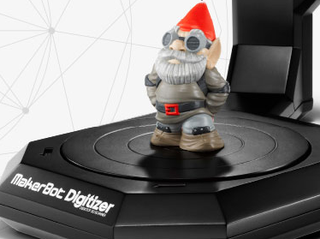Scanners Could Bring 3D Printing to the Masses
3D printers aren't household items yet, but advancements in the field will give almost anyone the ability to produce their own creations.


NEW YORK — 3D printers aren't exactly common household items just yet, but according to MakerBot founder and CEO Bre Pettis, new advancements in the field will give just about anyone the ability to scan, tweak and produce his or her own creations.
Speaking at the Maker Innovation Hardware conference at the New York Science Center this week, Pettis outlined how 3D printing is becoming an increasingly populist pursuit.
The primary stumbling block for novice 3D printing enthusiasts, Pettis explained, was the high learning curve of grappling with design software. Although material for 3D printers like MakerBot's own Replicator line is relatively cheap, each creation takes a few hours. Printing a total dud is not an efficient option.
MORE: 3D printing projects: 10 Great 3D-Printing Projects
This is where MakerBot's new 3D scanner, the Digitizer, comes into play. By digitally scanning an existing object, Pettis hopes that amateur modelers can "jumpstart the design process."
"We can create a model in 12 minutes that we can poke at," said Pettis. Scanning an existing object — like a fork, a toy soldier or a statue of a gnome (MakerBot's preferred test model) — may not be as creatively fulfilling as starting a project from scratch. However, it's much easier for a newcomer to dive in with a frame of reference.
To test his "anyone can be a designer" philosophy, Pettis has conscripted his two-year-old daughter, Nika, as a test subject. Nika is currently experimenting with making her own sculptures out of Play-Doh.
Sign up to get the BEST of Tom’s Guide direct to your inbox.
Upgrade your life with a daily dose of the biggest tech news, lifestyle hacks and our curated analysis. Be the first to know about cutting-edge gadgets and the hottest deals.
Pettis intends to use the Digitizer to scan these structures, help his daughter tweak them on a computer and print them using a MakerBot Replicator. Although reproducing a two-year-old's artwork may not be the most exciting use for a 3D printer, Nika is likely to appreciate it. This way, she can save her favorite designs while repurposing the Play-Doh for new projects.
The point of this exercise, Pettis explained, was not to suggest that every child needs a 3D printer, but rather to imagine how people's mindsets might be different if they had been exposed to design philosophy at a very young age.
MORE: Best 3D Printers 2013
The idea that design is no longer restricted to career engineers is a powerful one, according to Pettis: MakerBot's Thingiverse servers receive 200 new designs from users every day, and there's no sign of the submission rate slowing down.
Although there are more sophisticated machines than the Replicator and the Digitizer available, Pettis argued that the ease-of-use of MakerBot's machines will help bring more people into the 3D printing fold. "The tool that you know is the best tool," he said.
Whether everyday consumers will really embrace 3D printing is yet to be seen. The prices are still too high for people to buy the machines merely as curiosities: the Digitizer costs $1,400, and the Replicator 2 costs $2,199 (neither price includes extended warranty insurance or printing filaments).
There are also some very legitimate concerns about the utility of 3D printing for the average consumer. You could download or scan a design for a perfectly good plastic cup or shopping basket, but actually printing one would cost much more money than buying a mass-produced object.
The mass-produced object would also have a smoother finish, and a company to receive complaints should the product not function as specified. The benefits of 3D printing are obvious for Etsy designers or industrial prototypers — even NASA and Lockheed Martin have embraced the trend. For standard household tasks, though, the machines are still somewhat hard to justify.
Still, Pettis pointed out that five years ago, there would have been no market to sustain even these expensive products. The democratization of 3D printing has only just begun, but user-friendly scanning provides a much more approachable starting point than dealing with complex modeling software.
"People who can do software really well are rare," Pettis said. "When you find them, be nice to them."
Follow Marshall Honorof @marshallhonorof. Follow us @tomsguide, on Facebook and on Google+.
Marshall Honorof is a senior editor for Tom's Guide, overseeing the site's coverage of gaming hardware and software. He comes from a science writing background, having studied paleomammalogy, biological anthropology, and the history of science and technology. After hours, you can find him practicing taekwondo or doing deep dives on classic sci-fi.

